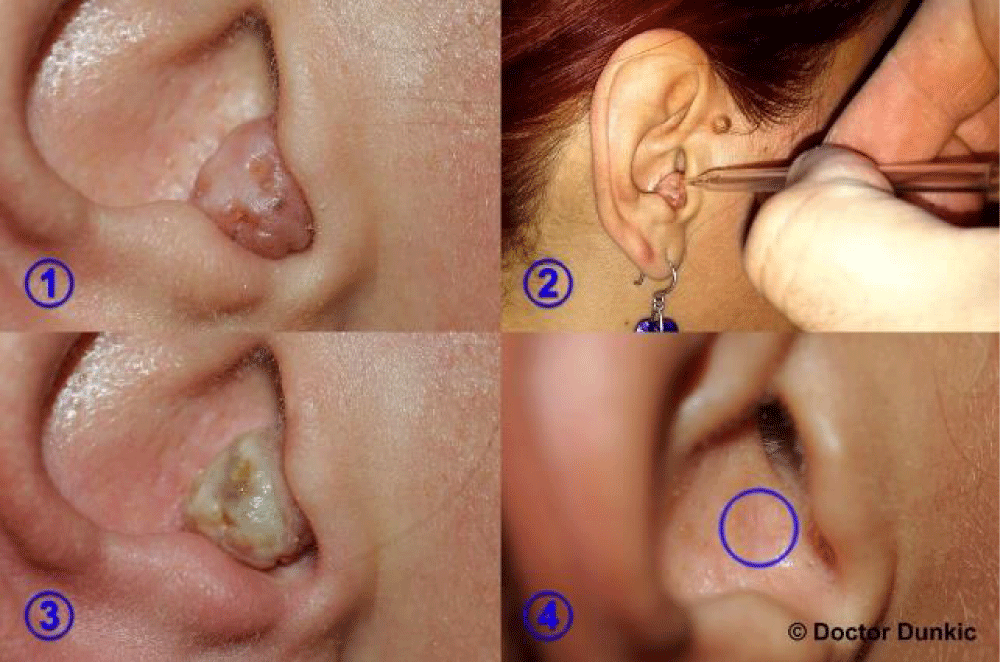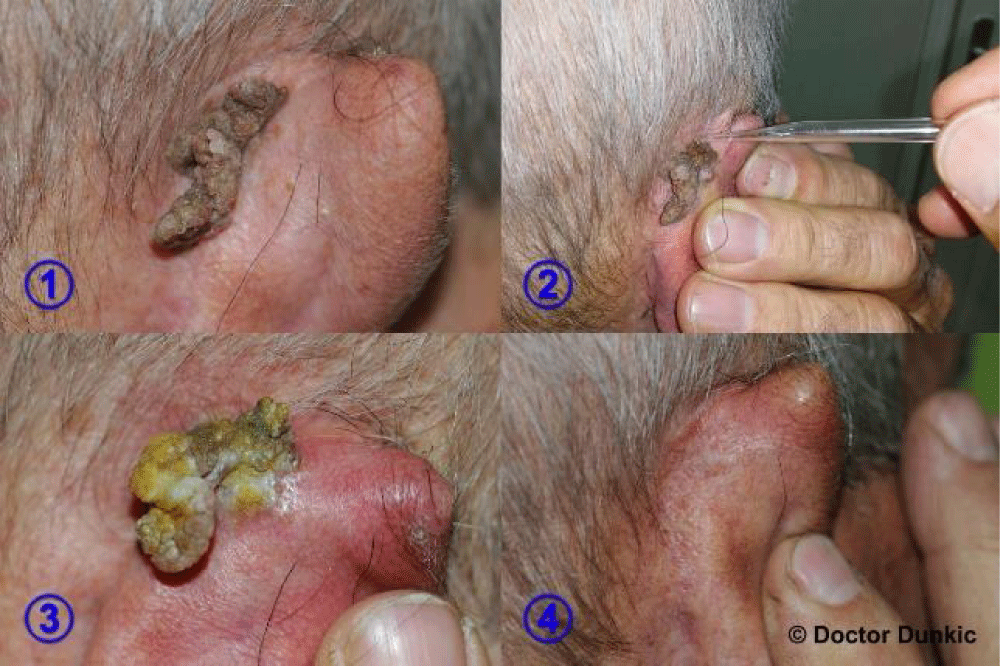Global Journal of Medical and Clinical Case Reports
Examples of removing benign lesions using the chemical method according to DR. G. DUNKIC
Natasa Djordjevic1,2*, Aleksandar Dunkic3 and Marina Djordjevic2
1Institute for Technology of Nuclear and Other Row Materials, Franše ‘dEperea Boul. 86, Belgrade, Serbia 2Health Care Clinic Apiderm Plus, Stojana Aralice 6, Belgrade, Serbia 3Health Care Clinic Dunkic, Lepenicki Boul. 1 Kragujevac, Serbia
Cite this as
Djordjevic N, Dunkic A, Djordjevic M. Examples of removing benign lesions using the chemical method according to DR. G. DUNKIC. Glob J Medical Clin Case Rep. 2025:12(7):159-160. Available from: 10.17352/2455-5282.000218Copyright License
© 2025 Djordjevic N, et al. This is an open-access article distributed under the terms of the Creative Commons Attribution License, which permits unrestricted use, distribution, and reproduction in any medium, provided the original author and source are credited.In practice, patients with a large number of benign lesions are often encountered, which are impractical to remove using classical methods such as surgery, laser or radio wave methods. Therefore, a method of removing benign lesions with a chemical preparation according to Dr. Dunkic has been developed, which does not require anesthesia, can be applied simultaneously to a large number of lesions, and is very comfortable for patients. The paper presents examples of the application of the chemical method of removing benign lesions on two patients. Monitoring of patients, even after many years from the moment of removal of the lesions, no changes were observed in the treated areas.
Introduction
Chemical preparations, mainly keratolytics, are used in clinics, which are used more or less successfully to remove keratoses, age spots on the skin, psoriasis and verrucas [1-3]. Benign lesions can appear from early childhood to throughout life (especially keratoses) and can significantly worsen the quality of life. The increasing index of solar radiation, as well as other aspects that have a beneficial, but also subjective effect on people dealing with these problems, have proven to be a reason to develop a method that helps such patients get rid of benign lesions in a simple, safe, effective and with maximum aesthetic characteristics. The aim of this publication is to systematically review the role of the chemical preparation according to Dr. G. Dunkić in the treatment of such skin conditions [4-7].
The article presents two examples of chemical removal of benign lesions. The first example is a benign lesion with a benign raised naevus in a patient (42-year-old woman) in the ear. The lesion had been growing for the past 15 years, had not changed, and had not been injured over time. The patient wanted to have it removed for aesthetic reasons. This kind of benign lesion is an elevated growth that is harmless. It can grow over time, rarely altering into a malignant condition (Figure 1).
The second example is a patient (male) 67 years old with a Seborrheic keratosis. Seborrheic keratosis is a type of epidermal tumor. It usually occurs in older people, but it is not unusual for middle-aged people to have some. They are mostly removed for aesthetic reasons, and the biggest problem in removing them is their number, which can reach several hundred on the skin. It is certainly important to note that these are benign tumors and that they mostly appear in characteristic locations (back, neck, stomach), but they can also be found on the hairy part of the head, as well as in other areas.
Our patient’s keratosis was located behind the ear that had been growing for the past 7 years. The keratosis was crusted, itchy, and sometimes bled spot-like after sleeping. The patient wanted to have it removed for aesthetic and health reasons. The images show the lesion before, during, and a few months after treatment. The intervention did not require anesthesia; patients felt a slight stinging sensation during the application of the chemical. After treatment, the treated lesions turned into scabs (necrosis) and fell off after 3 weeks. The procedure in these patients did not require any changes. After epithelialization and scab detachment, dermoscopic examination did not show any pathological changes in the treated areas (Figure 2).
The participants were fully informed about the purpose, procedures, risks, and benefits of the study, which enabled them to make a voluntary and informed decision to participate.
The authors would like to thank the Ministry of Science, Technological Development and Innovation of the Republic of Serbia for the financial support of the research, the results of which are presented in the paper (contract 451-03-136/2025-03/200023).
- Jacobi A, Mayer A, Augustin M. Keratolytics and emollients and their role in the therapy of psoriasis: a systematic review. Dermatol Ther (Heidelb). 2015;5(1):1–18. Available from: https://doi.org/10.1007/s13555-015-0068-3
- Sadick NS, Coutanceau C, Sibaud V, Merial-Kien C. Efficacy and Safety of a New Topical Keratolytic Treatment for Localized Hyperkeratosis in Adults. J Drugs Dermatol. 2010;9(12):1512–7. Available from: https://pubmed.ncbi.nlm.nih.gov/21120259/
- Massiot P, Contreiras Pinto P, Leclerc-Mercier S, Rasmont V, Piraccini BM, Rudnicka L, et al. Clinical benefit and tolerance profile of a keratolytic and hydrating shampoo in subjects with mild to moderate psoriasis. Results from a double-blind, randomized, vehicle-controlled study. J Cosmet Dermatol. 2023;22:2050–3. Available from: https://doi.org/10.1111/jocd.15693
- Djordjević N, Dunkić A. 16th international congress: Scientific evidence in unconventional medicine. Digital platform ExpoDiP, 2025 Mar 21–Jun 30.
- Steeb T, Koch EAT, Wessely A, Wiest LG, Schmitz L, Berking C, et al. Chemical peelings for the treatment of actinic keratosis: a systematic review and meta-analysis. J Eur Acad Dermatol Venereol. 2021 Mar;35(3):641–9. Available from: https://doi.org/10.1111/jdv.16844
- Heppt MV, Steeb T, Leiter U, Berking C. Efficacy of photodynamic therapy combined with topical interventions for the treatment of actinic keratosis: a meta-analysis. J Eur Acad Dermatol Venereol. 2019;33(5):863–73. Available from: https://doi.org/10.1111/jdv.15459
- Heppt MV, Steeb T, Ruzicka T, Berking C. Cryosurgery combined with topical interventions for actinic keratosis: a systematic review and meta-analysis. Br J Dermatol. 2019;180(4):740–8. Available from: https://doi.org/10.1111/bjd.17435






